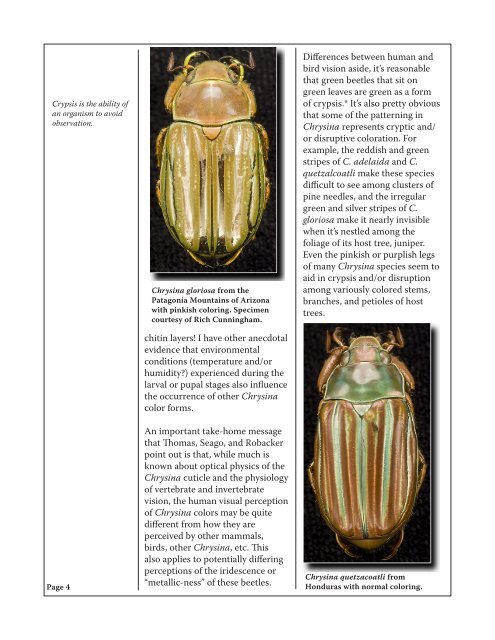SCARABS - University of Nebraska State Museum
SCARABS - University of Nebraska State Museum
SCARABS - University of Nebraska State Museum
Create successful ePaper yourself
Turn your PDF publications into a flip-book with our unique Google optimized e-Paper software.
Crypsis is the ability <strong>of</strong><br />
an organism to avoid<br />
observation.<br />
Page 4<br />
Chrysina gloriosa from the<br />
Patagonia Mountains <strong>of</strong> Arizona<br />
with pinkish coloring. Specimen<br />
courtesy <strong>of</strong> Rich Cunningham.<br />
chitin layers! I have other anecdotal<br />
evidence that environmental<br />
conditions (temperature and/or<br />
humidity?) experienced during the<br />
larval or pupal stages also influence<br />
the occurrence <strong>of</strong> other Chrysina<br />
color forms.<br />
An important take-home message<br />
that Thomas, Seago, and Robacker<br />
point out is that, while much is<br />
known about optical physics <strong>of</strong> the<br />
Chrysina cuticle and the physiology<br />
<strong>of</strong> vertebrate and invertebrate<br />
vision, the human visual perception<br />
<strong>of</strong> Chrysina colors may be quite<br />
different from how they are<br />
perceived by other mammals,<br />
birds, other Chrysina, etc. This<br />
also applies to potentially differing<br />
perceptions <strong>of</strong> the iridescence or<br />
“metallic-ness” <strong>of</strong> these beetles.<br />
Differences between human and<br />
bird vision aside, it’s reasonable<br />
that green beetles that sit on<br />
green leaves are green as a form<br />
<strong>of</strong> crypsis.* It’s also pretty obvious<br />
that some <strong>of</strong> the patterning in<br />
Chrysina represents cryptic and/<br />
or disruptive coloration. For<br />
example, the reddish and green<br />
stripes <strong>of</strong> C. adelaida and C.<br />
quetzalcoatli make these species<br />
difficult to see among clusters <strong>of</strong><br />
pine needles, and the irregular<br />
green and silver stripes <strong>of</strong> C.<br />
gloriosa make it nearly invisible<br />
when it’s nestled among the<br />
foliage <strong>of</strong> its host tree, juniper.<br />
Even the pinkish or purplish legs<br />
<strong>of</strong> many Chrysina species seem to<br />
aid in crypsis and/or disruption<br />
among variously colored stems,<br />
branches, and petioles <strong>of</strong> host<br />
trees.<br />
Chrysina quetzacoatli from<br />
Honduras with normal coloring.
















